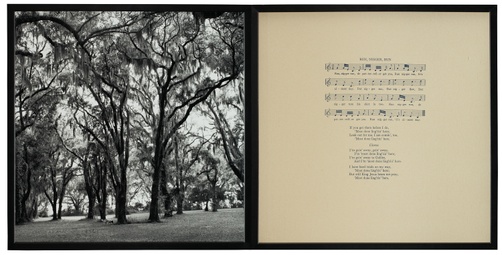Taina Cotto ’20
Skidmore College
Art can evoke emotion and tell stories in ways more powerful than words. Viewing Run Nigger Run, I was initially drawn to the nature photograph. The scenery is beautiful, and I could see a younger me running around in the wooded area, but when I read the lyrics of “Run Nigger Run,” that vision suddenly became a demented one. The song and image together bring back thoughts of enslaved people desperately attempting to escape the South, a place with beautiful land but the horror of slavery. The lyrics—running from the “patty-roller” who would catch enslaved people in their escape—take the scene from being a natural, serene woods to an eerie place where human beings ran for their lives. At the center of the photograph is a slight clearing in the trees—seemingly the perfect escape. But when merged with the lyrics, the clear path becomes a space to be easily found by a slave hunter. The clearing had potential to be a symbol for hope, but instead it became a symbol of despair. The idea of running from the “patty-rollers” and from the racism and oppression of the South on an island becomes symbolic of how black people in the South were trapped in their experiences, told to run but with nowhere to go.
Katie Coggins ’20
Skidmore College
Using the combined power of music and lyrics with the graphic depiction of the landscape, Carrie Mae Weems invokes a history deeply imbedded within the place and culture of the American South to create a dialogue with the present. The juxtaposition of the delicacy of the trees and the upsetting lyrics of the music taint the image with an unsettling sensation, poisoning it with violence. Alongside the sing-song lyrics of the song, the moss-draped cypress trees attain an eerie sensation and conjure the memory of lynching photography, their hanging moss taking the place of bodies.
The theme of running, as presented in the song, implies seeking safety or better conditions. In this way, the song acts not only as a representation of the past but as a symbol of modern African Americans trying to escape harsh conditions.(1) Escape seems to be an enduring dream. Problems of the past are the forbearers to the problems of the present and are not distinct and dead. The running may have started here, but it is far from over. The disadvantages African Americans face today go beyond outright violence: they include education, employment, living standards, health care, and security. Run Nigger Run seems to call into question the advancements that have been made since the time the folk song was written.

